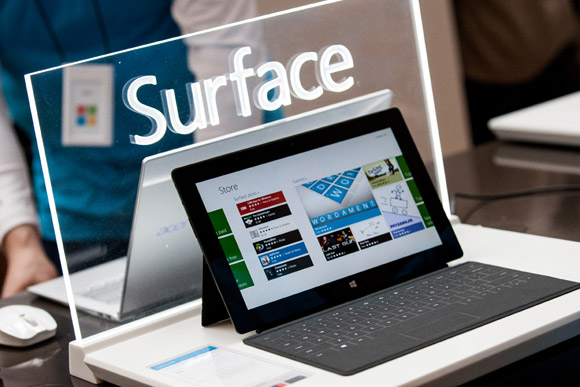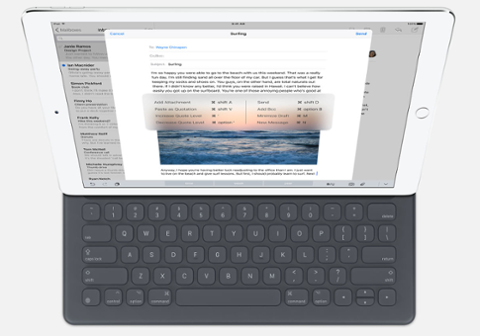 Windows 8 tablets: too large for their own good?[/caption] Microsoft hopes that Windows 8 will give it a significant presence in the tablet market. If new estimates from research firm IDC prove accurate, however, Microsoft will seize a little more than 10 percent of the tablet operating-system market by 2017—lagging well behind Google Android and Apple’s iOS, which will effectively dominate the tablet world with 46 percent and 43.5 percent market-share, respectively. IDC criticizes Microsoft for its decision to push two versions of Windows 8. In addition to the “regular” version of the operating system, architected to run on Intel’s x86 chips, Microsoft has been pushing Windows RT, a version built for ARM-based systems. While ARM powers a majority of the mobile device market, the forking of Windows RT onto the architecture also resulted in some baked-in disadvantages; for example, Windows RT can’t run legacy Windows applications built for x86-based hardware, forcing anyone using an RT tablet to either find an equivalent or do without. "Microsoft's decision to push two different tablet operating systems, Windows 8 and Windows RT, has yielded poor results in the market so far," Tom Mainelli, research director of tablets for IDC, wrote in a statement. "Consumers aren't buying Windows RT's value proposition, and long term we think Microsoft and its partners would be better served by focusing their attention on improving Windows 8. Such a focus could drive better share growth in the tablet category down the road." In the short term, IDC feels that the tablet market will do better than expected in 2013, driven in large part by a “surge” of lower-priced tablets. The firm also feels that consumers are gravitating towards smaller form-factors such as the iPad Mini. "One in every two tablets shipped this quarter was below 8 inches in screen size. And in terms of shipments, we expect smaller tablets to continue growing in 2013 and beyond" Jitesh Ubrani, research analyst for IDC's Tablet Tracker, wrote in a statement accompanying the data. "Vendors are moving quickly to compete in this space as consumers realize that these small devices are often more ideal than larger tablets for their daily consumption habits." That could be bad news for Microsoft. So far, the company has focused on larger tablet form-factors, as epitomized by its flagship Surface tablet at 10.6 inches. There’s a reason for that: from day one, Microsoft has pushed Windows 8 as a “no compromises” platform, one capable of giving users that speedy, lightweight tablet experience alongside the ability to run fully featured apps such as Office. But if consumers want tablets more in line with their smartphones—small and light, meant mostly for consumption and “lighter” apps—then Microsoft will have zigged where the rest of the industry zagged. And then, as IDC predicted, its tablet market-share will stay low. Image: Microsoft
Windows 8 tablets: too large for their own good?[/caption] Microsoft hopes that Windows 8 will give it a significant presence in the tablet market. If new estimates from research firm IDC prove accurate, however, Microsoft will seize a little more than 10 percent of the tablet operating-system market by 2017—lagging well behind Google Android and Apple’s iOS, which will effectively dominate the tablet world with 46 percent and 43.5 percent market-share, respectively. IDC criticizes Microsoft for its decision to push two versions of Windows 8. In addition to the “regular” version of the operating system, architected to run on Intel’s x86 chips, Microsoft has been pushing Windows RT, a version built for ARM-based systems. While ARM powers a majority of the mobile device market, the forking of Windows RT onto the architecture also resulted in some baked-in disadvantages; for example, Windows RT can’t run legacy Windows applications built for x86-based hardware, forcing anyone using an RT tablet to either find an equivalent or do without. "Microsoft's decision to push two different tablet operating systems, Windows 8 and Windows RT, has yielded poor results in the market so far," Tom Mainelli, research director of tablets for IDC, wrote in a statement. "Consumers aren't buying Windows RT's value proposition, and long term we think Microsoft and its partners would be better served by focusing their attention on improving Windows 8. Such a focus could drive better share growth in the tablet category down the road." In the short term, IDC feels that the tablet market will do better than expected in 2013, driven in large part by a “surge” of lower-priced tablets. The firm also feels that consumers are gravitating towards smaller form-factors such as the iPad Mini. "One in every two tablets shipped this quarter was below 8 inches in screen size. And in terms of shipments, we expect smaller tablets to continue growing in 2013 and beyond" Jitesh Ubrani, research analyst for IDC's Tablet Tracker, wrote in a statement accompanying the data. "Vendors are moving quickly to compete in this space as consumers realize that these small devices are often more ideal than larger tablets for their daily consumption habits." That could be bad news for Microsoft. So far, the company has focused on larger tablet form-factors, as epitomized by its flagship Surface tablet at 10.6 inches. There’s a reason for that: from day one, Microsoft has pushed Windows 8 as a “no compromises” platform, one capable of giving users that speedy, lightweight tablet experience alongside the ability to run fully featured apps such as Office. But if consumers want tablets more in line with their smartphones—small and light, meant mostly for consumption and “lighter” apps—then Microsoft will have zigged where the rest of the industry zagged. And then, as IDC predicted, its tablet market-share will stay low. Image: Microsoft Microsoft Will Only Hold 10 Percent of Tablet Market by 2017: IDC
[caption id="attachment_8452" align="aligncenter" width="580"]  Windows 8 tablets: too large for their own good?[/caption] Microsoft hopes that Windows 8 will give it a significant presence in the tablet market. If new estimates from research firm IDC prove accurate, however, Microsoft will seize a little more than 10 percent of the tablet operating-system market by 2017—lagging well behind Google Android and Apple’s iOS, which will effectively dominate the tablet world with 46 percent and 43.5 percent market-share, respectively. IDC criticizes Microsoft for its decision to push two versions of Windows 8. In addition to the “regular” version of the operating system, architected to run on Intel’s x86 chips, Microsoft has been pushing Windows RT, a version built for ARM-based systems. While ARM powers a majority of the mobile device market, the forking of Windows RT onto the architecture also resulted in some baked-in disadvantages; for example, Windows RT can’t run legacy Windows applications built for x86-based hardware, forcing anyone using an RT tablet to either find an equivalent or do without. "Microsoft's decision to push two different tablet operating systems, Windows 8 and Windows RT, has yielded poor results in the market so far," Tom Mainelli, research director of tablets for IDC, wrote in a statement. "Consumers aren't buying Windows RT's value proposition, and long term we think Microsoft and its partners would be better served by focusing their attention on improving Windows 8. Such a focus could drive better share growth in the tablet category down the road." In the short term, IDC feels that the tablet market will do better than expected in 2013, driven in large part by a “surge” of lower-priced tablets. The firm also feels that consumers are gravitating towards smaller form-factors such as the iPad Mini. "One in every two tablets shipped this quarter was below 8 inches in screen size. And in terms of shipments, we expect smaller tablets to continue growing in 2013 and beyond" Jitesh Ubrani, research analyst for IDC's Tablet Tracker, wrote in a statement accompanying the data. "Vendors are moving quickly to compete in this space as consumers realize that these small devices are often more ideal than larger tablets for their daily consumption habits." That could be bad news for Microsoft. So far, the company has focused on larger tablet form-factors, as epitomized by its flagship Surface tablet at 10.6 inches. There’s a reason for that: from day one, Microsoft has pushed Windows 8 as a “no compromises” platform, one capable of giving users that speedy, lightweight tablet experience alongside the ability to run fully featured apps such as Office. But if consumers want tablets more in line with their smartphones—small and light, meant mostly for consumption and “lighter” apps—then Microsoft will have zigged where the rest of the industry zagged. And then, as IDC predicted, its tablet market-share will stay low. Image: Microsoft
Windows 8 tablets: too large for their own good?[/caption] Microsoft hopes that Windows 8 will give it a significant presence in the tablet market. If new estimates from research firm IDC prove accurate, however, Microsoft will seize a little more than 10 percent of the tablet operating-system market by 2017—lagging well behind Google Android and Apple’s iOS, which will effectively dominate the tablet world with 46 percent and 43.5 percent market-share, respectively. IDC criticizes Microsoft for its decision to push two versions of Windows 8. In addition to the “regular” version of the operating system, architected to run on Intel’s x86 chips, Microsoft has been pushing Windows RT, a version built for ARM-based systems. While ARM powers a majority of the mobile device market, the forking of Windows RT onto the architecture also resulted in some baked-in disadvantages; for example, Windows RT can’t run legacy Windows applications built for x86-based hardware, forcing anyone using an RT tablet to either find an equivalent or do without. "Microsoft's decision to push two different tablet operating systems, Windows 8 and Windows RT, has yielded poor results in the market so far," Tom Mainelli, research director of tablets for IDC, wrote in a statement. "Consumers aren't buying Windows RT's value proposition, and long term we think Microsoft and its partners would be better served by focusing their attention on improving Windows 8. Such a focus could drive better share growth in the tablet category down the road." In the short term, IDC feels that the tablet market will do better than expected in 2013, driven in large part by a “surge” of lower-priced tablets. The firm also feels that consumers are gravitating towards smaller form-factors such as the iPad Mini. "One in every two tablets shipped this quarter was below 8 inches in screen size. And in terms of shipments, we expect smaller tablets to continue growing in 2013 and beyond" Jitesh Ubrani, research analyst for IDC's Tablet Tracker, wrote in a statement accompanying the data. "Vendors are moving quickly to compete in this space as consumers realize that these small devices are often more ideal than larger tablets for their daily consumption habits." That could be bad news for Microsoft. So far, the company has focused on larger tablet form-factors, as epitomized by its flagship Surface tablet at 10.6 inches. There’s a reason for that: from day one, Microsoft has pushed Windows 8 as a “no compromises” platform, one capable of giving users that speedy, lightweight tablet experience alongside the ability to run fully featured apps such as Office. But if consumers want tablets more in line with their smartphones—small and light, meant mostly for consumption and “lighter” apps—then Microsoft will have zigged where the rest of the industry zagged. And then, as IDC predicted, its tablet market-share will stay low. Image: Microsoft
 Windows 8 tablets: too large for their own good?[/caption] Microsoft hopes that Windows 8 will give it a significant presence in the tablet market. If new estimates from research firm IDC prove accurate, however, Microsoft will seize a little more than 10 percent of the tablet operating-system market by 2017—lagging well behind Google Android and Apple’s iOS, which will effectively dominate the tablet world with 46 percent and 43.5 percent market-share, respectively. IDC criticizes Microsoft for its decision to push two versions of Windows 8. In addition to the “regular” version of the operating system, architected to run on Intel’s x86 chips, Microsoft has been pushing Windows RT, a version built for ARM-based systems. While ARM powers a majority of the mobile device market, the forking of Windows RT onto the architecture also resulted in some baked-in disadvantages; for example, Windows RT can’t run legacy Windows applications built for x86-based hardware, forcing anyone using an RT tablet to either find an equivalent or do without. "Microsoft's decision to push two different tablet operating systems, Windows 8 and Windows RT, has yielded poor results in the market so far," Tom Mainelli, research director of tablets for IDC, wrote in a statement. "Consumers aren't buying Windows RT's value proposition, and long term we think Microsoft and its partners would be better served by focusing their attention on improving Windows 8. Such a focus could drive better share growth in the tablet category down the road." In the short term, IDC feels that the tablet market will do better than expected in 2013, driven in large part by a “surge” of lower-priced tablets. The firm also feels that consumers are gravitating towards smaller form-factors such as the iPad Mini. "One in every two tablets shipped this quarter was below 8 inches in screen size. And in terms of shipments, we expect smaller tablets to continue growing in 2013 and beyond" Jitesh Ubrani, research analyst for IDC's Tablet Tracker, wrote in a statement accompanying the data. "Vendors are moving quickly to compete in this space as consumers realize that these small devices are often more ideal than larger tablets for their daily consumption habits." That could be bad news for Microsoft. So far, the company has focused on larger tablet form-factors, as epitomized by its flagship Surface tablet at 10.6 inches. There’s a reason for that: from day one, Microsoft has pushed Windows 8 as a “no compromises” platform, one capable of giving users that speedy, lightweight tablet experience alongside the ability to run fully featured apps such as Office. But if consumers want tablets more in line with their smartphones—small and light, meant mostly for consumption and “lighter” apps—then Microsoft will have zigged where the rest of the industry zagged. And then, as IDC predicted, its tablet market-share will stay low. Image: Microsoft
Windows 8 tablets: too large for their own good?[/caption] Microsoft hopes that Windows 8 will give it a significant presence in the tablet market. If new estimates from research firm IDC prove accurate, however, Microsoft will seize a little more than 10 percent of the tablet operating-system market by 2017—lagging well behind Google Android and Apple’s iOS, which will effectively dominate the tablet world with 46 percent and 43.5 percent market-share, respectively. IDC criticizes Microsoft for its decision to push two versions of Windows 8. In addition to the “regular” version of the operating system, architected to run on Intel’s x86 chips, Microsoft has been pushing Windows RT, a version built for ARM-based systems. While ARM powers a majority of the mobile device market, the forking of Windows RT onto the architecture also resulted in some baked-in disadvantages; for example, Windows RT can’t run legacy Windows applications built for x86-based hardware, forcing anyone using an RT tablet to either find an equivalent or do without. "Microsoft's decision to push two different tablet operating systems, Windows 8 and Windows RT, has yielded poor results in the market so far," Tom Mainelli, research director of tablets for IDC, wrote in a statement. "Consumers aren't buying Windows RT's value proposition, and long term we think Microsoft and its partners would be better served by focusing their attention on improving Windows 8. Such a focus could drive better share growth in the tablet category down the road." In the short term, IDC feels that the tablet market will do better than expected in 2013, driven in large part by a “surge” of lower-priced tablets. The firm also feels that consumers are gravitating towards smaller form-factors such as the iPad Mini. "One in every two tablets shipped this quarter was below 8 inches in screen size. And in terms of shipments, we expect smaller tablets to continue growing in 2013 and beyond" Jitesh Ubrani, research analyst for IDC's Tablet Tracker, wrote in a statement accompanying the data. "Vendors are moving quickly to compete in this space as consumers realize that these small devices are often more ideal than larger tablets for their daily consumption habits." That could be bad news for Microsoft. So far, the company has focused on larger tablet form-factors, as epitomized by its flagship Surface tablet at 10.6 inches. There’s a reason for that: from day one, Microsoft has pushed Windows 8 as a “no compromises” platform, one capable of giving users that speedy, lightweight tablet experience alongside the ability to run fully featured apps such as Office. But if consumers want tablets more in line with their smartphones—small and light, meant mostly for consumption and “lighter” apps—then Microsoft will have zigged where the rest of the industry zagged. And then, as IDC predicted, its tablet market-share will stay low. Image: Microsoft 

